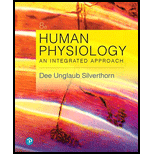
(a)
To determine: The number of molecules of NaCl present in 1L of solution of 1.0M NaCl having 58.5g of salt per liter.
Introduction: Molarity of a solution is defined as the number of moles of solute present in 1 liter of solution. The unit of molarity is mol/L. The molarity of the solution is used to express the concentration of the solution.
(b)
To determine: The number of millimoles of NaCl presents in the solution of 1.0M NaCl containing 58.5g of salt per liter.
Introduction: The mole is the SI unit that measures the amount of a substance. One mole is equal to the
(c)
To determine: The number of equivalents of sodium ions present in the 1.0M solution of NaCl.
Introduction: The concentration of ions present in a solution is expressed as the number of equivalents per liter. One equivalent is equal to the number of charges carried by one molarity of ions.
(d)
To determine: The percent solution of 58.5g of NaCl per liter.
Introduction: The concentration of the solute in a solution is expressed by percent solution. It means a 10% solution is 10 parts of solute in 100 parts of solution. The amount of solute in a percent solution is expressed as the percentage of total solution weight or volume.
Want to see the full answer?
Check out a sample textbook solution
Chapter 2 Solutions
Pearson eText Human Physiology: An Integrated Approach -- Instant Access (Pearson+)
- In one paragraph show how atoms and they're structure are related to the structure of dna and proteins. Talk about what atoms are. what they're made of, why chemical bonding is important to DNA?arrow_forwardWhat are the structure and properties of atoms and chemical bonds (especially how they relate to DNA and proteins).arrow_forwardThe Sentinel Cell: Nature’s Answer to Cancer?arrow_forward
- Molecular Biology Question You are working to characterize a novel protein in mice. Analysis shows that high levels of the primary transcript that codes for this protein are found in tissue from the brain, muscle, liver, and pancreas. However, an antibody that recognizes the C-terminal portion of the protein indicates that the protein is present in brain, muscle, and liver, but not in the pancreas. What is the most likely explanation for this result?arrow_forwardMolecular Biology Explain/discuss how “slow stop” and “quick/fast stop” mutants wereused to identify different protein involved in DNA replication in E. coli.arrow_forwardMolecular Biology Question A gene that codes for a protein was removed from a eukaryotic cell and inserted into a prokaryotic cell. Although the gene was successfully transcribed and translated, it produced a different protein than it produced in the eukaryotic cell. What is the most likely explanation?arrow_forward
- Molecular Biology LIST three characteristics of origins of replicationarrow_forwardMolecular Biology Question Please help. Thank you For E coli DNA polymerase III, give the structure and function of the b-clamp sub-complex. Describe how the structure of this sub-complex is important for it’s function.arrow_forwardMolecular Biology LIST three characteristics of DNA Polymerasesarrow_forward
 Human Biology (MindTap Course List)BiologyISBN:9781305112100Author:Cecie Starr, Beverly McMillanPublisher:Cengage Learning
Human Biology (MindTap Course List)BiologyISBN:9781305112100Author:Cecie Starr, Beverly McMillanPublisher:Cengage Learning Biology (MindTap Course List)BiologyISBN:9781337392938Author:Eldra Solomon, Charles Martin, Diana W. Martin, Linda R. BergPublisher:Cengage Learning
Biology (MindTap Course List)BiologyISBN:9781337392938Author:Eldra Solomon, Charles Martin, Diana W. Martin, Linda R. BergPublisher:Cengage Learning





